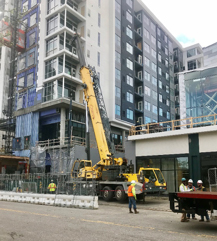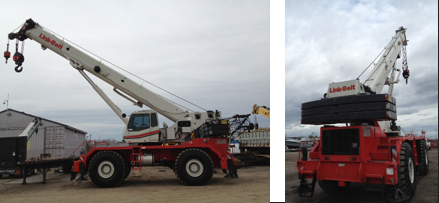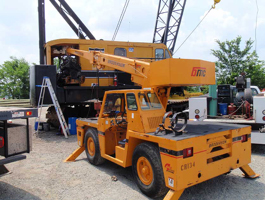Your Guide to Hydraulic Crane Rental
Do you have an upcoming project that requires some heavy lifting?
Cranes add value to your job by lifting heavy objects safely and efficiently. However, because of what they do and the inherent risk of lifting heavy objects way into the air, cranes are unique. Crane equipment comes with its own set of terminology. You need to understand how a crane works to know which one will best do the job at hand.
You also need to understand with some specifics about your job site needs, since that can really change what type of crane you might use.
Expect to need a hydraulic crane on your job site and want to understand as much as possible about different cranes and their uses? Read on to learn all there is to know about the different types of hydraulic cranes and how they can work for you.
Crane Terminology
The general purpose of a crane is to do the heavy lifting on a job site. Its role is to lift materials and place them where they are needed. Like any kind of equipment, there is some crane terminology to understand associated with its use.
Let’s take a look at the vocabulary connected to cranes and their use.
Assist Crane
The assist crane comes along with another crane so it can aid in the assembly of the workhorse crane.
Booms
This is the part of the crane you associate with when you see a crane’s outline in the sky. It is the long arm of the crane that is used to place the materials on the job site.
Counterweights
These are the weights that help not only keep the crane on the ground but also balanced as it lifts the heavy materials where it needs to go.
Reach
Here is where your crane specialist does some math. Reach is calculated by factoring how high and how far you need to lift from where the crane is located. Consider your arm stretched from your body. Your reach is how high and/or how far your arm can be while lifting something and keeping your feet planted in one spot.
Riggers
A rigger is a person whose responsibility is to set up the rigging on the crane. This rigging has the pulleys and cables that are used for lifting and moving the materials on the job site.
Self-Erecting
A self-erecting crane can use its own parts to assemble itself once it arrives on a job site.
Sheaves
Sheaves are the pulleys used as part of the rigger system used by the crane to do the lifting.
FAQ for Crane Needs
You know you need a crane but figuring out which crane you need requires some additional knowledge. When you talk to a crane specialist, they are likely to ask you a series of questions about your job site to help them zero in on the best crane to do the job.
Here are some of the questions you should be prepared to answer about your job site.
- How much weight do you need to lift?
- How high do you need to lift the materials?
- How far do you need to reach with a boom?
- What is the duration of the job?
- How close can you get the crane to the location you plan to offload the materials?
- What are the conditions at the job site?
- Is it a rough construction site, paved, smooth surface?
- How much time will you have to set the crane up?
- Will the crane be able to do everything you need to do from one location?
The more details you can provide to your crane specialist, the better. All this will help your crane specialist determine the best crane for your job.
Transport, Set-Up and Service
Transport, set-up, and service are three factors to consider in getting a crane to your job site. Because of the sheer size of many cranes, no matter the type, transporting them is specialized. Some cranes will need to be transported in parts and assembled on the job site.
A large crane needing significant counterweight, for example, might come with boom parts on one truck, counterweights on another. Then the assist crane will come separately too. Be prepared to also need specialized set-up. The crane company might deliver the equipment and with it will come a crane company employee who specializes in getting the crane set up for use. Crofton Crane Rental & Rigging provides the skilled personnel and equipment for transport and setup of the crane at your job site.
One service you will want to discuss with the crane company is the riggers. Will they do the rigging for you? Will they require you to get a rigging service or perhaps allow you to rig it yourself?
Rigging a crane is highly specialized because of the associated risk. You want to be certain to have your crane rigging done by an expert to avoid accidents or injury on the worksite. Crofton Crane Rental & Rigging can supply certified riggers for every lift. Crofton’s riggers are trained through Rigger 1 & Rigger 2 training which covers proper inspection and use of various types of slings, verifying load weight, sling length, safety practices, and more.

Types of Hydraulic Cranes
There are a variety of different hydraulic cranes, each with unique features. The more details you can provide about your job, the easier it will be for your crane specialist to identify which crane is right for you. Let’s take a closer look at the different types of hydraulic cranes, their unique features, and how they can add value to your job site.
Hydraulic Truck Crane

The hydraulic truck crane or the HTC is amongst the most versatile and most used cranes on job sites. If you have seen a crane in action on a construction site, there’s a good chance it was an HTC. They are usually one of the largest cranes available. They offer the most boom length. Many of the HTC units available have a boom length of between 127 and 142 feet. This tells you the height the boom can reach from the base of the crane.
One feature of the HTC is the removable counterweights. This allows the crane to be transported more easily and more economically. The removable counterweights come off the crane for transport and are put back on once on the job site. The counterweights are added to the crane depending on the amount of weight that needs to be lifted.
Another nice feature of the HTC is its ability to drive the unit to the site then add the counterweights. That means it does not need to be transported there. Only the counterweights need transport.
HTC units can be self-erecting or need an assist crane for assembly depending on the unit.
Rough Terrain Crane

The rough terrain crane is unique because it can handle the rough and uneven terrain of an unimproved construction site. It comes with big and wide flotation tires. These tires allow the rough terrain crane to maintain its balance on the uneven surface of the job site. It also must have outriggers. These outriggers come from the unit to get it balanced before doing any lifting.
While the rough terrain crane is not typically as large as an HTC unit, it can still do some heavy lifting. There are rough terrain cranes that can lift between 18 and 150 tons of weight. The boom in this type of crane is hydraulic. When in operation, a lever is pulled and the hydraulics kick into action, raising, lowering and moving the boom as needed.
A rough terrain crane needs to be transported to a job site on a lowboy truck. Once it’s on the job site and unloaded, the crane can be driven on the job site to where it needs to go.
Carry Deck Crane

Carry deck cranes are smaller and often used in more industrial settings. They can be used in tight spaces because they have a small footprint. Often this type of crane has non-marking tires. This allows it to move around in an industrial setting and not damage the flooring surfaces.
This type of crane can come with a diesel or gas engine. But they also will often come with a propane powered engine allowing them to operate without heavy fumes inside. The carry deck crane is unique because it can carry the load it needs to lift. So, in an industrial setting, it can carry tooling or steel piping, for example, on the deck of the machine. This crane can also move around on a job site.
So, once it can carry the load to where it needs to be lifted, then it can also do the lifting as needed. This is referred to as the pick and carry, which is a unique feature of this crane. Because this crane is often more compact, it is also less complex to operate. The carry deck crane, however, does need to be moved on a lowboy truck to the worksite
Boom Truck

A boom truck is also unique because it can be driven on the road. Instead of needing to haul this crane it can be driven. Boom trucks have a large deck. This carry deck allows them to carry a load to the job site.
For example, a boom truck could pick up a large HVAC unit that needs to go on a roof. It could carry the HVAC unit to the building. Then it could get in place, put down its outriggers and lift the HVAC unit into place.
This is unique because it can unload materials it carried itself to the job site. They typically have long booms but don’t lift as much weight as some other cranes. They can lift between 26 and 40 tons of weight. This type of crane tends to be less complicated to operate than some of the larger other models.
Find the Right Hydraulic Crane for Your Job
A hydraulic crane can be quite the workhorse on the job or construction site. They are unique machines that require specialized knowledge and experience. If you need help with the heavy lifting on your job site but aren’t sure which crane will work best for you, we can help. Contact us today to request a quote and get more information. We are available 24/7 at 757-397-1131.
Crofton Crane Rental & Rigging maintains a premium hydraulic crane rental fleet ranging from carry decks and boom trucks to hydraulic truck, rough terrain, and all terrain cranes. Our diverse fleet services all areas of Hampton Roads (Portsmouth, Norfolk, Chesapeake, Suffolk, Virginia Beach, Hampton, and Newport News) and extends up to Williamsburg and Petersburg, westward into Emporia, and all the way down to north east North Carolina.
Request Quote| Category | Manufacturer | Model | Tonnage (capacity) | Boom | Jib Length | Load Chart | Images | |
|---|---|---|---|---|---|---|---|---|
| Request Quote | Information | Load Chart | Carrydeck | Shuttlelift | 5560RT | 15 | 54.5 | 15 | https://www.crofton.com/wp-content/uploads/2015/12/Shuttlelift-5560RT-rev.pdf | Array |
| Request Quote | Information | Load Chart | Boom Truck | Manitex | 2601C | 26 | 101 | 29 | https://www.crofton.com/wp-content/uploads/2015/12/Manitex-26101C-rev.pdf | |
| Request Quote | Information | Load Chart | Rough Terrain Crane | Link-Belt | RTC 8050 | 50 | 110 | 0 | https://www.crofton.com/wp-content/uploads/2015/12/Linkbelt-RTC-8050-load-chart.pdf | |
| Request Quote | Information | Load Chart | Rough Terrain Crane | Link-Belt | RTC8090 Series II | 90 | 140 | 35 | https://www.crofton.com/wp-content/uploads/2015/12/Linkbelt-HTC8690-Series-II-load-chart-1.pdf | Array |
| Request Quote | Information | Load Chart | Rough Terrain Crane | Grove | RT635C | 35 | 105 | 29 | https://www.crofton.com/wp-content/uploads/2015/12/Grove-RT635C-rev.pdf | Array |
| Request Quote | Information | Load Chart | All Terrain Crane | Grove | GMK5165 | 165 | 310 | 59.1 | https://www.crofton.com/wp-content/uploads/2015/12/Grove-GMK5165-rev.pdf | Array |
| Request Quote | Information | Load Chart | Boom Truck | Manitex | 40124SHL | 40 | 123.5 | https://www.crofton.com/wp-content/uploads/2018/04/Manitex-40124SHL.pdf | Array | |
| Request Quote | Information | Load Chart | HTC | Link-Belt | 8675 | 75 | 127 | 64 | https://www.crofton.com/wp-content/uploads/2018/11/Link-Belt-HTC8675-Load-Chart.pdf | Array |
| Request Quote | Information | Load Chart | All Terrain Crane | Grove | GMK5150L | 175 | 197 | 110 | https://www.crofton.com/wp-content/uploads/2020/04/Grove-GMK-5150L.pdf | |
| Request Quote | Information | Load Chart | All Terrain Crane | Liebherr | LTM 1130-5.1 | 155 | 197 | 109 | https://www.crofton.com/wp-content/uploads/2020/04/Liebherr-LTM-1130-5.1.pdf | |
| Request Quote | Information | Load Chart | HTC | Grove | TMS9000-2 | 115 | 169 | 57 | https://www.crofton.com/wp-content/uploads/2021/03/115-ton-Grove.pdf | |
| Request Quote | Information | Load Chart | HTC | Liebherr | LTM 1090-4.2 | 110 | 197 | 52 | https://www.crofton.com/wp-content/uploads/2021/03/110-Ton-Liebherr.pdf | |
| Request Quote | Information | Load Chart | All Terrain Crane | Link-Belt | ATC 3210 | 210 | 200 | 67 | https://www.crofton.com/wp-content/uploads/2025/02/Load-Chart-Feb-2025.pdf | Array |
Our hydraulic crane rental services offer fully operated and maintained or bare rental, long-term or day rental, rigging services, permitting, crane plans, and/or load tests. We can also provide spreader bars and crane mats. Whether it’s an HVAC unit or non-containerized cargo, residential construction or structural demolition, steel erection or vessel decommissioning–we’ve got the equipment and the experience for the job.
We know that emergencies can’t wait until the next business day. That’s why we’ve been responding 24/7, since 1949. Our cranes are third party inspected and regularly serviced and maintained–ready for anything at any time. All operators are CDL licensed, VDOT medically certified, NCCCO certified and maintain DBID, TWIC cards, and other various access credentials that provide clearance to all local government installations and privately owned highly sensitive facilities. Crofton also provides in house OSHA training, Rigger 1 & 2 training, and Signal Person training.
Want to see more? View our entire fleet of rental equipment here.